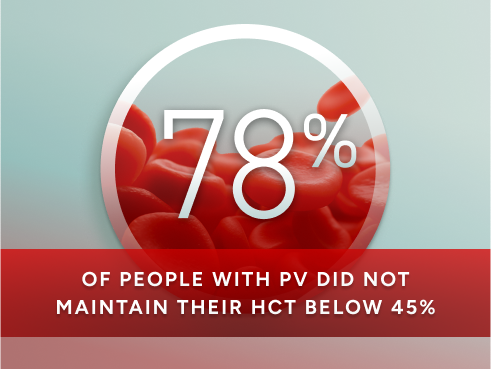
Managing PV
Treatment Goals

Treatment goals
Keeping your hematocrit (HCT, the amount of red blood cells in your blood) below the 45% threshold, is an important way to reduce your chances of a blood clot or heart attack.
In a large clinical study called CYTO-PV, people with PV who had HCT levels above the 45% threshold, specifically 45%-50%, were 4 times more likely to have a blood clot or a heart problem compared to those who kept it below 45%.
Other important treatment goals include reduction of PV symptoms and increasing quality of life so that you can still pursue your daily activities.
You know best how PV affects your daily life.
Working with your doctor to define treatment goals and address both symptoms and expectations can help improve your PV management.
Find tools and guides to help you manage your PV symptoms
Make doctor appointments even more productive by bringing a completed symptom tracker
Current Treatments
Current treatment options for PV
A primary goal of treatment is to consistently maintain your red blood cells (hematocrit levels) below the 45% threshold.
Although PV can also increase white blood cells and platelets, there are no recommended thresholds for those levels, meaning that red blood cell overproduction is still the earliest and most consistent sign of the disease.
Therapeutic phlebotomy and low-dose aspirin
Therapeutic phlebotomy and low-dose aspirin
Initial treatment may include low-dose aspirin to help lower the risk of blood clots, typically along with therapeutic phlebotomy.
Therapeutic phlebotomy, sometimes just called phlebotomy, is usually the first treatment you will have for your PV.
While a standard phlebotomy is used for diagnostic purposes and blood donation, therapeutic phlebotomy is specifically used to treat your PV as an interim treatment for temporary hematocrit reduction. This helps lower the number of red blood cells and reduce the thickness of your blood.
You may have therapeutic phlebotomy done regularly, especially at the beginning of treatment. Over time, the schedule may change depending on your blood counts. Therapeutic phlebotomies are a common part of PV care, but when they’re unpredictable, they can add stress and uncertainty to daily life.
People with PV undergoing therapeutic phlebotomy vs phlebotomy for diagnostic purposes will need to undergo more frequent treatments, as often as 8 times a year. Each visit can take several hours. All that time, travel, and scheduling can make it harder to keep up with daily routines, work, and life. Those living with PV often report being fatigued and dizzy after several blood draws. They may also become intolerant and it may be difficult to gain access to the appropriate vein. If symptoms or complications worsen, phlebotomy may not be enough and cytoreductive therapies may be considered by your doctor.
Cytoreductive therapies (eg, hydroxyurea, interferons, JAK inhibitors)
Cytoreductive therapies (eg, hydroxyurea, interferons, JAK inhibitors)
Cytoreductive therapies are medications that help slow down how many blood cells your body makes.
Hydroxyurea, or HU, is an oral chemotherapy that is frequently used in PV, although it can be difficult to tolerate.
It is common for people with PV to need to continue therapeutic phlebotomy to help control fluctuating HCT levels, either at first or intermittently, when receiving cytoreductive therapy for PV.
JAK inhibitors and interferon therapy are other treatment options for advanced PV, and are mainly used after trying other therapies.
Cytoreductive therapies may be initially recommended if you’re over 60, have had a blood clot, or if phlebotomy alone isn’t keeping your PV under control.
Some cytoreductive therapies require a period of time before they begin to work, which could be upwards of ~8 months, so you need to stay vigilant with monitoring during this time.
Many currently approved cytoreductive therapies are associated with high rates of discontinuation due to side effects, which occur in up to 1/3 of those with PV.

4 out of 5 people with PV did not consistently maintain their HCT below the 45% threshold, despite their current treatment.
